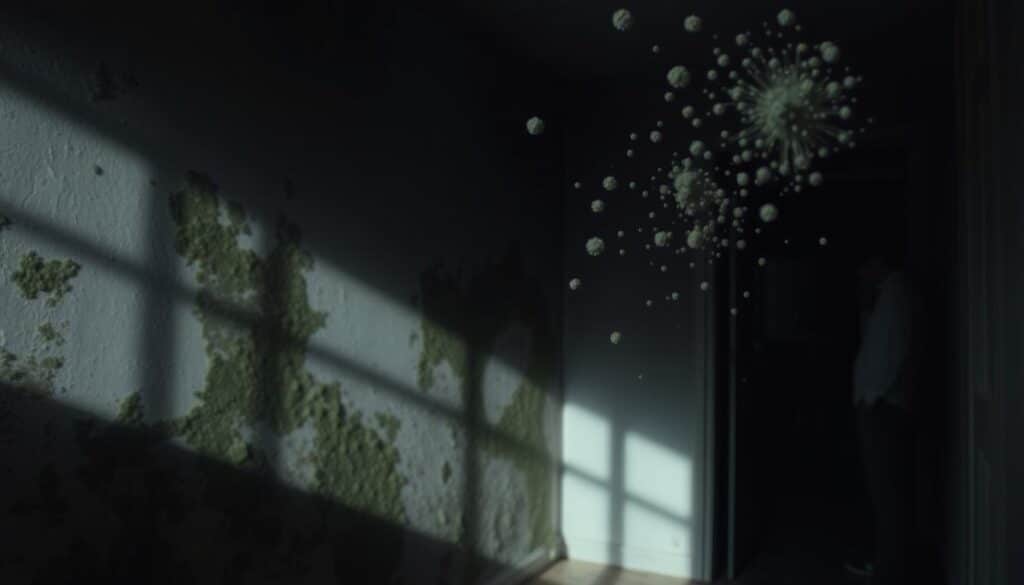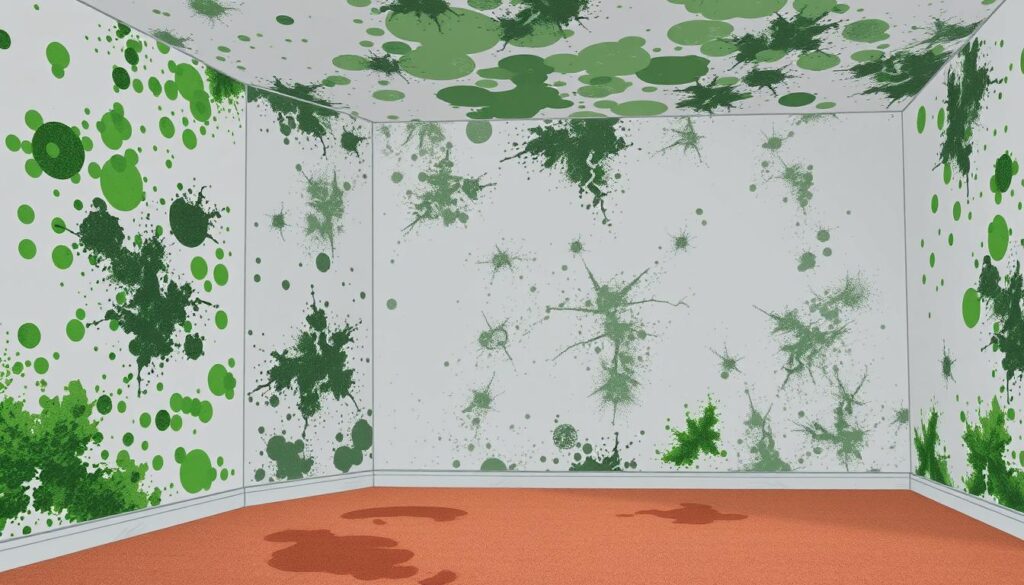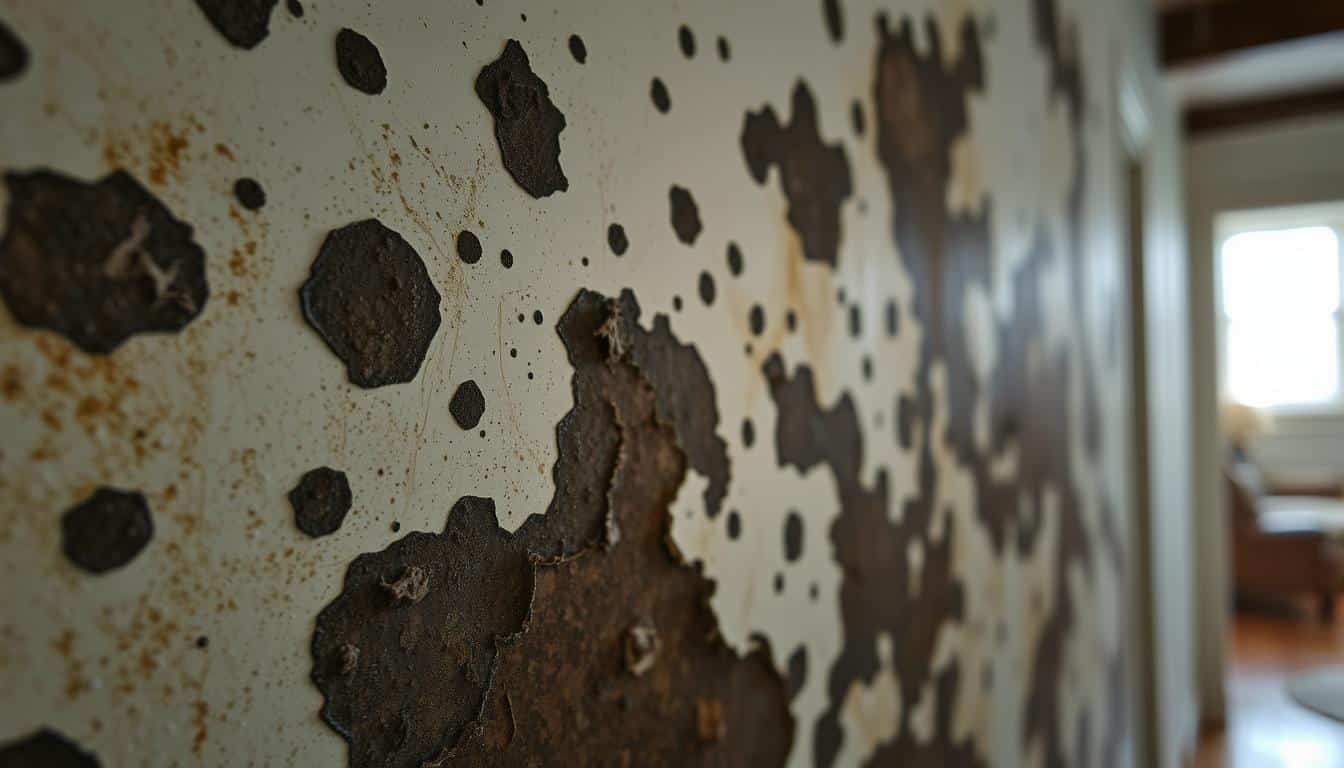Mold can grow quickly after water damage, with some types spreading in just 24 to 48 hours. This fast growth shows why it’s key to act fast to stop mold. Mold can cause health problems like headaches, fatigue, and breathing issues.
So, knowing how mold grows and controlling moisture is vital. It helps keep your home safe and your family healthy.
Key Takeaways
- Mold can start growing within 24-48 hours after water damage occurs
- Mold thrives in warm, humid environments and feeds on organic materials like wood and drywall
- Mold spores can spread rapidly and survive in various indoor areas
- Prompt moisture removal and professional mold remediation are crucial to prevent extensive damage
- Exposure to mold can lead to serious health issues, making mold prevention a top priority
What Causes Mold Growth After Water Damage?
Water damage from flooding, leaks, or high humidity creates perfect conditions for mold growth. Mold spores, tiny airborne particles, are everywhere. They quickly turn into visible mold colonies after water damage.
Mold needs moisture and organic materials to thrive. Floodwater or high indoor humidity provides the moisture it needs to grow.
Moisture and Organic Materials
The longer materials and surfaces stay wet, the more likely mold will develop. Organic materials like wood, paper, and fabrics are mold’s favorite food. When these materials get wet, they become mold’s breeding ground.
If moisture isn’t addressed quickly, mold can fill the air and spread. This can harm your health.
Mold Spores in the Air
Mold spores are everywhere and can easily get into your home. They come in through open doors, windows, or on your clothes. When moisture is present, these spores can activate and multiply fast.
The more moisture and organic materials there are, the faster mold grows. This can harm your home’s air quality and structure.
“Mold colonies can start growing on a damp surface within 24 to 48 hours. Mildew and mold will develop in a home within 24-48 hours of water exposure.”
How Quickly Can Mold Start Growing?
The EPA and CDC say mold can start growing on surfaces in 24 to 48 hours after water exposure. At this early stage, the mold spores are not visible. It takes about 18 to 21 days for the mold spores to colonize and show up.
The 24-48 Hour Window
Mold can start growing in just a few hours if conditions are right. If moisture is not dried out within 48 hours, mold is likely to grow. The exact time depends on temperature, humidity, organic materials, and water damage extent.
Factors Influencing Mold Growth Rate
Several factors affect how fast mold grows after water damage:
- Time the water has been present: Longer water exposure leads to faster mold growth.
- Temperature: Higher temperatures provide ideal conditions for mold to regenerate quickly.
- Ventilation: Adequate airflow can reduce the speed of mold growth.
- Organic surfaces: Availability of carbon-based materials facilitates rapid mold spread.
- Inorganic surfaces: Surfaces like inorganic paints can slow down mold growth.
Keeping a home cool and well-ventilated after water damage is crucial to slowing down the mold growth process.
How Fast Can Mold Grow After Water Damage
Mold can spread quickly after water damage, threatening your home and health. Knowing how fast mold grows is key to stopping it early.
Experts say mold can start on wet drywall or carpet in 24 to 48 hours. In two to four weeks, you can see it growing, spreading about one square inch daily.
Moisture, temperature, and organic materials affect mold growth. Leaks, flooding, or trapped humidity create the perfect mold environment.
Mold can hide but will grow again when conditions are right. Quick action is crucial to stop mold from spreading in your home.
Act fast to remove standing water to prevent mold. A professional water damage team within an hour can help. They ensure mold doesn’t spread and fix the damage right.
Don’t try to remove mold yourself. It can make things worse. Leave it to the experts who know how to safely and effectively remove it.
Dangers of Mold Exposure
Being around certain types of mold can harm your health. It can cause headaches, fatigue, rashes, allergic reactions, and breathing issues. People with allergies or asthma are at higher risk. Any mold inside should be removed quickly to avoid harm.
Health Risks from Mold
Mold can seriously affect your health. Symptoms include sinus and nasal congestion, itchy eyes, wheezing, and coughing. It can also cause skin irritation, asthma attacks, and headaches.
Repeated exposure to mold can lead to more serious health problems. These include chronic sinusitis, organ damage, and even Legionnaire’s disease. It can also trigger allergies and asthma in children.
Babies, children, pregnant women, and older adults are more vulnerable to mold. People with weakened immune systems or chronic conditions are also at risk. If you have persistent symptoms, see a doctor to find the cause, which might be mold.
While black mold isn’t proven to be deadly, it can still cause problems. To stay safe, avoid touching moldy items and keep rooms well-ventilated. For big mold problems, get professional help. Taking these steps can protect your health from mold dangers.

“Exposure to certain species of mold can be dangerous to your health, leading to common symptoms like headaches, fatigue, rashes, allergic reactions, and respiratory problems.”
Preventing Mold Growth After Water Damage
Stopping mold growth after water damage is key to a healthy home. Quick action to fix water issues is essential. The sooner you clean and dry, the less mold you’ll face.
Fixing leaks and finding hidden moisture are crucial steps. Removing wet materials and using dehumidifiers help a lot. Good ventilation in the first 24-48 hours is also important.
The Environmental Protection Agency (EPA) says mold can grow in 24 to 48 hours after a flood. Spores start to show in 18 to 21 days after flooding.
Acting fast and drying areas well reduces mold risk. But, just drying might not get rid of all spores. Professional mold removal is often needed to keep your home mold-free.
By controlling moisture, keeping air moving, and fixing water damage quickly, you can stop mold. This way, you keep your home safe and healthy.
| Mold Growth Timeline | Timeframe |
|---|---|
| Mold can begin to develop on surfaces | 24 to 48 hours of water exposure |
| Mold spores start to colonize and become apparent | 18 to 21 days after the flooding event |
| Mold can start to grow under favorable conditions | As quickly as a few hours |
By following these steps, you can protect your home from mold. This keeps your indoor space healthy and safe.
Signs of Mold Infestation
Identifying a mold problem in your home involves looking for certain signs. Visible mold growth on surfaces is a clear indicator. Mold can spread quickly, becoming more common over time. A musty, damp smell also suggests mold, even if you can’t see it.
Visible Growth and Musty Odors
Discoloration, staining, or a fuzzy texture on surfaces could mean mold. Mold can be black, green, white, or pink. A musty odor is another sign, even if you can’t see it.
It’s crucial to tackle mold signs quickly. Mold can grow and spread, posing health risks and damaging your home. Taking action fast can prevent a small problem from getting worse.
| Mold Type | Appearance | Health Risks |
|---|---|---|
| Stachybotrys atra (Black Mold) | Black or dark green, slimy texture | Severe allergic reactions, especially in sensitive or immunocompromised individuals |
| Cladosporium | Olive green or brown, powdery texture | Respiratory issues, skin irritation |
| Aspergillus | Black, white, or yellow hues, cottony or granular texture | Lung infections, especially in those with weakened immune systems |
| Alternaria | Dark green or brown, velvety texture | Allergic reactions, asthma symptoms |
If you think you have mold, act fast and call a professional. They can assess the problem and fix it, stopping signs of mold and musty odors.

Mold Remediation Steps
When you face a mold problem after water damage, acting fast is key. If the mold covers more than 10 square feet, the EPA says to call a pro. These experts can figure out how bad it is and safely get rid of the mold.
Assessing the Extent of Damage
A licensed team will check the mold area to see how big the problem is. This usually takes 1-2 days. They look closely and take samples for tests. With this info, they can make a plan to fix it right.
Proper Containment and Removal
After they know what they’re up against, the team starts the cleanup. They seal off the area and use special machines to stop spores from spreading. They also get rid of any moldy stuff. The cleanup can take 1 to 5 days, depending on how bad it is.
Getting rid of mold is important to make your home safe again. Working with experts means you can count on them to remove the mold. They make sure the area is clean and safe to prevent mold from coming back.
When to Call Professional Mold Remediation Services
If you spot a big mold problem at home, it’s wise to get mold remediation services from pros. The EPA says to call a pro if you see more than 10 square feet of mold. Trying to clean up big mold yourself can be risky. Mold spores in the air can spread the problem.
Experts have the right tools and know-how to safely remove mold. They make sure your home is safe and comfy again. They also find out why the mold grew and how to stop it from coming back.
Here are some signs you need to call mold professionals:
- Big mold growth, covering more than 10 square feet
- Musty smells that keep coming back after cleaning
- Health issues like breathing problems or allergies
- Mold in tricky spots like behind walls or in crawl spaces
Don’t take chances with your family’s health or your home’s safety. For big mold problems, it’s best to get help from the experts for mold remediation services.
| Reason to Call Mold Professionals | Consequence of Attempting DIY Mold Removal |
|---|---|
| Large mold growth (over 10 sq ft) | Mold spores can spread, worsening the problem |
| Persistent musty odors | Failure to identify and address the root cause |
| Unexplained health issues | Continued exposure to harmful mold toxins |
| Mold in hard-to-reach areas | Incomplete remediation, leading to regrowth |
By getting mold remediation services from pros, you ensure the job is done right. Your home will be safe and free from mold again.
Tips for Moisture Control and Mold Prevention
To stop mold after water damage, it’s key to control moisture and keep your home dry. A few strategies can help a lot in preventing mold.
Dehumidification and Ventilation
First, use a dehumidifier to keep humidity under 50%. Mold loves damp, moist places. So, a dry, cool home is vital. Also, good ventilation helps air move and keeps humidity down.
- Utilize dehumidifiers to maintain indoor humidity below 50%
- Improve ventilation in your home to promote air circulation and reduce moisture buildup
- Promptly address any leaks or water damage to prevent mold growth
By controlling moisture and promoting mold prevention through dehumidification and ventilation, you can lower mold risks after water damage.
| Mold Prevention Measure | Benefit |
|---|---|
| Maintaining humidity levels between 30-50% | Starves mold of the moisture it needs to thrive |
| Ensuring proper ventilation | Improves air circulation and reduces humidity |
| Promptly addressing water leaks or damage | Prevents the creation of a damp environment ideal for mold growth |
By being proactive in moisture control and mold prevention, you can safeguard your home and family. This protects against mold’s health risks and damage to your home.
Conclusion
Mold can grow fast after water damage, often in 24-48 hours. Moisture, organic materials, and temperature affect how fast it grows. It’s important to fix water damage and moisture quickly to stop mold from spreading.
Being quick to act when water damage happens is key. Mold can grow aggressively in 24 to 48 hours after water damage. Fast drying and restoration in 1-2 days can stop mold growth.
Mold is a big risk to your home and health. It can make allergies worse, cause breathing problems, and harm vulnerable people. Stay alert, control humidity, and get professional help when needed to protect your home and family from mold.
FAQ
How fast can mold grow after water damage?
Mold can start growing on surfaces within 24 to 48 hours after water exposure. This growth depends on temperature, humidity, and organic materials available.
What causes mold growth after water damage?
Mold needs moisture and organic materials to grow. Water damage creates a perfect environment for mold spores to spread in homes.
How quickly can mold start growing after a water incident?
Mold can start growing on surfaces within 24 to 48 hours after water exposure. It may not be visible at first. It takes about 18 to 21 days for mold to fully colonize and show up.
How fast can mold spread after water damage?
Mold can grow significantly within 24 to 48 hours after water damage. If not treated, it can spread rapidly, taking hold of a home in as little as 12 days under ideal conditions.
What are the dangers of mold exposure?
Exposure to certain mold species can be hazardous to your health. It can cause headaches, fatigue, rashes, allergic reactions, and respiratory problems. Mold is especially dangerous for those with breathing issues from allergies or asthma.
How can I prevent mold growth after water damage?
To prevent mold, address water and moisture issues quickly. Fix leaks, remove water-damaged materials, use dehumidifiers, maintain good ventilation, and dry affected areas within 24-48 hours.
How can I tell if I have a mold problem?
Signs of a mold problem include visible mold growth and a musty, damp odor. If you notice these signs, address the issue promptly to prevent mold from spreading.
When should I call in professional mold remediation services?
The EPA recommends hiring a professional mold remediation company for more than 10 square feet of visible mold growth. DIY cleaning of large-scale mold infestations can be dangerous, as it releases spores into the air.
What are some tips for controlling moisture and preventing mold?
Key strategies include using dehumidifiers to keep humidity below 50%, ensuring proper ventilation, and promptly fixing any leaks or water damage. A dry, cool environment is essential to prevent mold growth.




